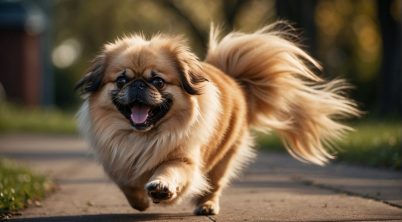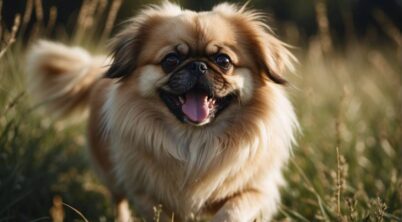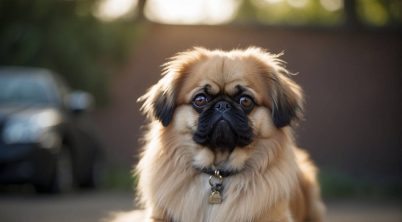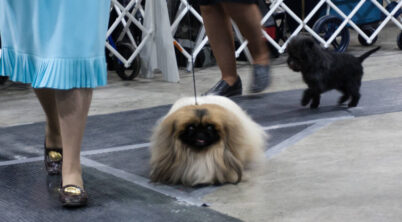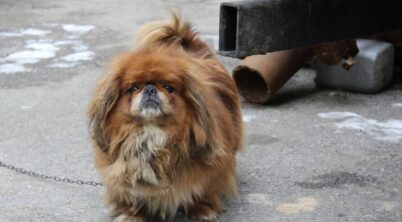Table of Contents
The Sleeve Pekingese Dog
The Pekingese, a toy dog breed known for their distinctive appearance, has a fascinating history that is deeply entwined with the last Chinese imperial dynasty. One of the breed’s most interesting uses played a unique role in the lives of Pekingese dogs during the times of the imperial court: they were carried in the sleeves of robes for warmth and protection. The breed was highly esteemed and often reserved for nobility, and owning a Pekingese with Emperor Sleeves was a sign of true luxury and prestige in ancient China.
For centuries, Pekingese were restricted to the confines of the Forbidden City and were seldom seen by commoners. Today, however, these extraordinary dogs continue to captivate dog enthusiasts around the world. As modern breeders and owners strive to maintain the rich history of the breed, the Pekingese remains a cherished companion and a symbol of sophistication and elegance in the dog world.
History of Pekingese Emperor Sleeves
The Pekingese breed, originating from China, has a history that dates back over 2,000 years. Emperors of the ancient Chinese dynasties favored this small-sized dog and often kept them as companions in the imperial palace. Emperor sleeve Pekingese, also known as “sleeve” dogs, were particularly cherished.
Sleeve Pekingese earned their name due to their small size and the habit of Chinese nobility carrying them within the large sleeves of their traditional garments. The main purpose of these miniature dogs was to provide companionship and entertainment to the royal family members.
Miniature sleeve Pekingese were selectively bred to maintain their small size and unique characteristics. They commonly weigh between 6 to 8 pounds, significantly smaller than their standard Pekingese counterparts, which can weigh up to 14 pounds.
During the invasion of foreign powers in the 1800s, many of the Pekingese dogs from the Emperor’s palace were taken and brought back to England. This brought the breed to the attention of the Western world, where they gained popularity as exotic pets for the upper class. Eventually, the breed’s popularity spread across Europe and North America.
In modern times, the American Kennel Club (AKC) recognizes the Pekingese breed, though it doesn’t specifically define a separate category for the sleeve Pekingese. However, enthusiasts and breeders continue to appreciate and preserve the unique qualities of these miniature dogs.
Significance in Chinese Culture
The Pekingese, also known as the Lion Dog or Fu Dog, has been cherished by Chinese royalty for centuries. Originally bred in the Imperial Palace in Peking (now Beijing), these small dogs have a rich cultural significance in Chinese history.
The miniature sleeve Pekingese has been particularly admired for its compact size and luxurious fur. These dogs were commonly carried around in the wide sleeves of Chinese emperors and imperial families, hence the name “sleeve Pekingese.” They served as symbols of wealth, status, and good fortune, signifying the wearer’s high social standing in ancient Chinese society.
Beyond their aesthetic appeal, the Pekingese were also believed to have spiritual significance. According to Chinese folklore, Pekingese dogs were created by the Buddha while merging a lion with a marmoset. This mystical origin story further elevated the status of these small dogs, contributing to their reputation as sacred animals.
The various features of the Pekingese breed were carefully selected and valued in China. For example:
- Lion-like appearance: As the dog is said to be part lion, their appearance was meant to represent strength, courage, and protectiveness.
- Golden red fur: The preferred color of the fur was a symbol of good luck and prosperity.
- Large, expressive eyes: The larger the eyes, the more spirituality they were believed to possess, further enhancing their connection to the divine.
Overall, sleeve Pekingese dogs have played an important role in Chinese culture and history, both as cherished companions and symbols of power, status, and spirituality.
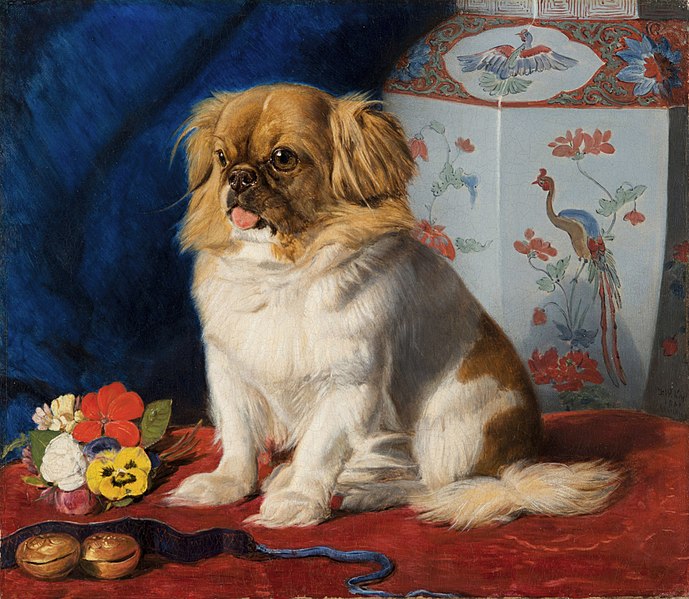
Emperor Sleeve Pekingese Dogs
Breed Characteristics
The Emperor Sleeve Pekingese is a smaller version of the well-known Pekingese breed. Specifically bred for their compact size and unique features, these miniature dogs typically weigh between 3 to 6 pounds. They possess a regal, lion-like appearance with a thick double coat, flat face, and large, expressive eyes.
Despite their small stature, Sleeve Pekingese have a strong-willed and confident personality. They are known to be loyal, affectionate, and often form strong bonds with their owners. Although their charming demeanor is endearing, early socialization and consistent training are essential for this breed to ensure proper behavior.
Health and Care
Like their standard-sized counterparts, Sleeve Pekingese dogs are prone to certain health issues. Some concerns include:
- Brachycephalic syndrome
- Eye problems (e.g., corneal ulcers, dry eye)
- Dental issues due to their small mouth
It is essential for owners to provide regular veterinary check-ups and maintain a proper grooming routine. The dense coat of this breed requires frequent brushing to prevent matting and ensure good skin health. Additionally, pay special attention to their eyes, ears, and teeth for any signs of issues.
As with all small breeds, it is important to monitor their diet and exercise to avoid obesity. While Sleeve Pekingese are not highly energetic, they do benefit from short, daily walks and playtime to maintain their physical and mental well-being.
Table: Emperor Sleeve Pekingese Overview
| Characteristic | Description |
|---|---|
| Size | 3 to 6 pounds |
| Coat | Dense double coat; various colors |
| Personality | Loyal, affectionate, strong-willed |
| Health Issues | Brachycephalic syndrome, eye problems, dental issues |
| Care Requirements | Regular grooming, veterinary check-ups, proper diet, and exercise |
Modern Interpretations and Revivals
In recent years, the Pekingese breed has experienced a resurgence of interest among dog enthusiasts. This has led to a growing appreciation for their history and unique characteristics. Miniature Sleeve Pekingese, also known as “Sleeve Peke”, have become more popular as pets, show dogs, and symbols of luxury.
The physical traits and attributes that define a Sleeve Pekingese include their small size, typically around 6-9 inches tall at the shoulder, and their significantly smaller weight, ranging from 3-6 pounds. This is in contrast to the standard Pekingese, which can weigh between 7-14 pounds.
Several organizations and breeders work to preserve and promote the Peke breed. This includes maintaining breed standards and organizing dog shows specifically focused on the Pekingese. The increase in breed awareness and popularity has resulted in a more diverse range of sleeve variants, demonstrating the rich history and versatility of this breed.
Modern interpretations of the Pekingese breed have been embraced not only by dog lovers, but also by artists and the fashion industry, who often use these regal dogs as inspiration for their work. For example, Sleeve Pekingese have been featured on textiles, accessories, and other forms of wearable art. Here are some ways that the Sleeve Pekingese has been celebrated in popular culture:
- Commemorative sculptures and artistic renderings
- High-fashion clothing and accessories featuring the breed’s likeness
- Television shows and movies centred around Emperor Sleeve Pekingese dogs
Despite their growing popularity, it is important to remember the responsibility of owning a Sleeve Pekingese. As with any pet, proper care, training, and attention are required to ensure a happy and healthy life for these unique and special dogs.
Conclusion
Miniature Sleeve Pekingese dogs have long been admired and beloved companions due to their unique and endearing appearance. With their distinct emperor sleeves and delicate nature, it’s no wonder they were once exclusively owned by Chinese royalty.
Today, this breed continues to captivate dog enthusiasts and pet owners around the world. Their small size and charming personality make them perfect for those living in smaller spaces, but they do require regular grooming and care to maintain their health and well-being.
When considering adding a Miniature Sleeve Pekingese to your family, it’s important to research reputable breeders and rescue organizations, ensuring that your new furry friend has a happy and healthy start to their life with you.
* Banner is from page 624 of “The dog book : a popular history of the dog, with practical information as to care and management of house, kennel, and exhibition dogs; and descriptions of all the important breeds” (1906) with the text: Text Appearing After Image: GROUP OF PEKINESE SPANIELS AND A SMOOTH “PUG’ Property of Mrs. E. B. Guyer, of Philadelphia. Imported from Pekin CHAON CHING WE Property of Mrs. M. H. Cotton, New Vork. Presented by the Empress Dowager to Miss Clara Kilbourne, in iqo2 (Public Domain)
